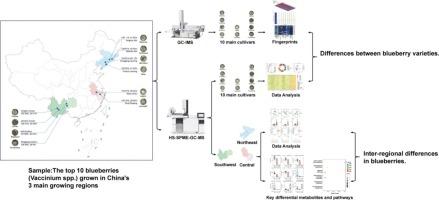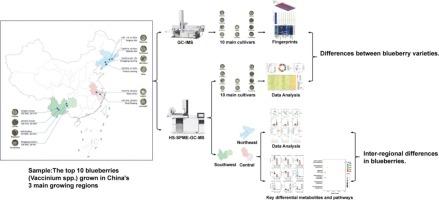Characterization and metabolism pathway of volatile compounds in blueberries of different varieties and origins analyzed via HS-GC-IMS and HS-SPME-GC–MS
IF 9.8
1区 农林科学
Q1 CHEMISTRY, APPLIED
引用次数: 0
Abstract
This study comprehensively identified 10 blueberry varieties from 3 regions using headspace gas chromatography ion mobility spectrometry (HS-GC-IMS) and headspace solid-phase microextraction gas chromatography–mass spectrometry (HS-SPME-GC–MS). The former identified 70 volatile organic compounds, while the latter identified 618. The blueberry varieties, Bluecrop, Reka, and Northland in Northeast China have significant advantages in fresh and sweet flavors were found through HS-GC-IMS. HS-SPME-GC–MS found that terpenes, esters, and heterocyclic are the main volatile components in blueberry (47.09 %), with nine volatile organic metabolites (benzene, 1,3-dimethyl, etc.) serving as potential biomarkers for distinguishing blueberry varieties from the three regions. In addition, the top 10 aromatic compounds in different blueberry varieties were screened, among which 5-ethyl-3-hydroxy-4-methyl-2 (5H) - furanone had the highest rOAV value. These findings provide theoretical support for exploring the key flavor characteristics of different varieties of blueberries and effectively distinguishing blueberries from various production areas.


采用HS-GC-IMS和HS-SPME-GC-MS对不同品种和产地蓝莓挥发物的特征及代谢途径进行了分析
采用顶空气相色谱-离子迁移谱法(HS-GC-IMS)和顶空固相微萃取气相色谱-质谱法(HS-SPME-GC-MS)对3个地区的10个蓝莓品种进行了综合鉴定。前者鉴定出70种挥发性有机化合物,后者鉴定出618种。通过HS-GC-IMS分析发现,中国东北地区蓝莓、瑞卡、北地等蓝莓品种在鲜甜风味方面具有显著优势。HS-SPME-GC-MS发现,萜类、酯类和杂环类是蓝莓的主要挥发性成分(47.09 %),其中苯、1,3-二甲基等9种挥发性有机代谢物可作为区分3个地区蓝莓品种的潜在生物标志物。此外,筛选了不同蓝莓品种的前10位芳香族化合物,其中5-乙基-3-羟基-4-甲基-2 (5H) -呋喃酮的rOAV值最高。这些发现为探索不同品种蓝莓的关键风味特征,有效区分不同产区蓝莓提供了理论支持。
本文章由计算机程序翻译,如有差异,请以英文原文为准。
求助全文
约1分钟内获得全文
求助全文
来源期刊

Food Chemistry
工程技术-食品科技
CiteScore
16.30
自引率
10.20%
发文量
3130
审稿时长
122 days
期刊介绍:
Food Chemistry publishes original research papers dealing with the advancement of the chemistry and biochemistry of foods or the analytical methods/ approach used. All papers should focus on the novelty of the research carried out.
 求助内容:
求助内容: 应助结果提醒方式:
应助结果提醒方式:


